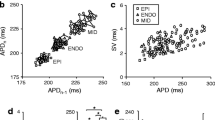Summary
Right ventricular repolarisation and refractoriness after therapeutic doses of disopyramide have been studied in 10 patients with coronary artery disease by recording monophasic action potentials (MAP) during programmed stimulation. Using 2 catheters, with the tip of one in the apex and the other in the outflow tract of right ventricle, conduction intervals for propagation of stimuli in the ventricle were also measured. Disopyramide increased the duration of MAP signals at 90% repolarisation (MAP90), the QT-interval and the right ventricular effective refractory period (V-ERP). The ratio refractoriness/action potential duration was slightly increased. Early premature action potentials were more markedly prolonged in relation to steady-state action potentials. The differences between the shortest and longest premature action potentials, however, were not changed significantly. The conduction intervals of the normal and premature paced beats were significantly prolonged.
The observed effects of disopyramide on conduction and action potential duration may be of major importance for its effect on termination and slowing ventricular tachycardias. Its influence on the duration of premature action potentials in man is consistent with the results of in vitro studies.
Similar content being viewed by others
References
Sekiya A, Vaughan Williams EM (1963) A comparison of the antifibrillatory actions and effects on intracellular cardiac potentials of pronethalol, disopyramide and quinidine. Br J Pharmacol 21: 473–481
Kus T, Sasyniuk N (1975) Electrophysiological actions of disopyramide phosphate on canine ventricular muscle and Purkinje fibres. Circ Res 37: 844–854
Varro A, Elharrar V, Surawicz B (1985) Effect of Antiarrhythmic drugs on the premature action potential duration in canine cardiac Purkinje fibers. J Pharmacol Exp Ther 233: 304–311
Colatsky TJ, Bird LB (1987) Class III antiarrhythmic agents do not alter recovery of premature action potential duration in dog Purkinje fibers (abstr). J Am Coll Cardiol 9: 156A
Olsson SB, Brorson L, Edvardsson N, Varnauskas E (1985) Estimation of ventricular repolarisation in man by monophasic action potential recording technique. Eur Heart J 6 [Suppl D]: 71–79
Edvardsson N, Hirsch I, Olsson SB (1984) Acute effects of lignocaine, procainamide, metoprolol, digoxin and atropine on human myocardial refractoriness. Cardiovasc Res 18: 463–470
Hoffman BF, Cranefield PF, Lepeschkin E, Surawicz B, Herrlich HC (1959) Comparison of cardiac monophasic action potentials recorded by intracellular and suction electrodes. Am J Physiol 196: 1297–1301
Franz MR, Burkhoff D, Spurgeon H, Weisfeldt ML, Lakatta EG (1986) In vitro validation of a new cardiac catheter technique for recording monophasic action potentials. Eur Heart J 7: 34–41
Endresen K, Amlie JP, Forfang K, Simonsen S, Jensen Ø (1987) Monophasic action potentials in patients with coronary artery disease: Reproducibility, electrical restitution and conduction at different rates of stimulation. Cardiovasc Res 21: 696–702
Franz MR (1983) Long-term recording of monophasic action potentials from human endocarcium. Am J Cardiol 51: 1629–1634
EMIT-cad (1980) Disopyramide Assay, Syva Inc, Palo Alto, CA
Bredesen JE, Pike A, Lunde PKM (1982) Plasma binding of disopyramide and mono-N-dealkyldisopyramide Br J Clin Pharmacol 14: 673–676
Kojima M (1981) Effects of disopyramide on transmembrane action potentials in guinea-pig papillary muscles. Eur J Pharmacol 69: 11–24
Bexton RS, Hellestrand KJ, Cory-Pearce R, Spurrell RAJ, English TAH, Camm AJ (1983) The direct electrophysiologic effects of disopyramide phosphate in the transplanted human heart. Circulation 67: 38–45
Lerman BB, Waxman HL, Buxton AE, Josephson ME (1983) Disopyramide: Evaluation of electrophysiologic effects and clinical efficacy in patients with sustained ventricular tachycardia or ventricular fibrillation. Am J Cardiol 51: 759–764
Endresen K, Amlie JP (1988) Propranolol-induced changes of early restitution in man: An indication of class I antiarrhythmic effect? Pace 11: 500 (abstract)
Olsson SB, Edvardsson N (1981) Clinical electrophysiologic study of antiarrhythmic properties of fleccainide: Acute intraventricular delayed conduction and prolonged repolarisation in regular paced and premature beats using intracardiac monophasic action potentials with programmed stimulation. Am Heart J 102: 864–871
Basset AL, Hoffman BF (1971) Antiarrhythmic drugs: Electrophysiological actions. Ann Rev Pharmacol 11: 143–170
Carmeliet E, Saikawa T (1982) Shortening of the action potential and reduction of pacemaker activity by lidocaine, quinidine and procainamide in sheep cardiac Purkinje fibers. An effect on Na+ or K+ currents. Circ Res 50: 257–275
Harper RW, Olsson SB, Varnauskas E (1979) Effect of mexiletine on monophasic action potentials recorded from the right ventricle in man. Cardiovasc Res 13: 303–310
Kuo CS, Amlie JP, Munakata K, Reddy CP, Surawicz B (1983) Dispersion of monophasic action potential durations and activation times during atrial pacing, ventricular pacing and ventricular premature stimulation in canine ventricles. Cardiovasc Res 17: 152–161
Bergfeldt L, Rosenquist M, Vallin H, Edhag O (1985) Disopyramide induced second and third degree atrioventricular block in patients with bifascicular block. Br Heart J 53: 328–334
Walton MK, Fozzard HA (1983) Experimental study of the conducted action potential in cardiac Purkinje strands. Biophys J 44: 1–8
Myerburg RJ, Stewart JW, Hoffman BF (1970) Electrophysiological properties of the canine peripherial A-V conducting system. Circ Res 26: 361–378
Spear JF, Moore EN (1974) Supernormal excitability and conduction in the His-Purkinje system of the dog. Circ Res 35: 782–792
Author information
Authors and Affiliations
Rights and permissions
About this article
Cite this article
Endresen, K., Amlie, J.P. & Forfang, K. Effects of disopyramide on repolarisation and intraventricular conduction in man. Eur J Clin Pharmacol 35, 467–474 (1988). https://doi.org/10.1007/BF00558240
Received:
Accepted:
Issue Date:
DOI: https://doi.org/10.1007/BF00558240



